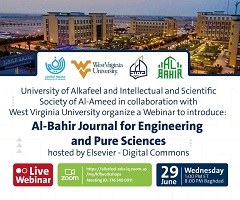Al-Bahir Journal for Engineering and Pure Sciences
Abstract
Background and objectives: The investigation of heavy-ion (HI) induced fusion processes in order to comprehend the many mechanisms involved in these reactions has long been a focus of nuclear physics. The complicated structure and behavior of projectile and target nuclei with various projectile energy allows us to define the reaction process and may aid in the investigation of the potential of creating superheavy elements (SHE) in the laboratory.
Methods: The semiclassical and full quantum mechanical complete fusion cross section calculations and the distribution of the fusion barrier for the systems 12C+50Ti,15N+56Fe,16O+63Cu and 40Ar+27Al. The calculations have been carried out by using SCF code for semiclassical and CC code for quantum mechanical calculations. To account for the target and projectile relative motion, we modified these codes. The fusion barrier distribution to be calculated directly from this code by subroutines written in Fortran language and added to the main code. The coupled-channel is considered by taking two channels only due to the difficulty of solving coupled differential equations.
Results: The obtained results for and the for the studied systems were compared to the related measured data and discussed.
Conclusion: The semiclassical method used to describe the fusion reaction agrees very well with the quantum method and with the measured data and we can conclude that this semiclassical method can be used as alternative to quantum method to study the fusion reaction.
Recommended Citation
Abdullhussein, Ruaa S.; Ahmed, Ghuzlan Sarhan; and Obaid, Sarah M.
(2023)
"Study of Fusion Reactions of some Light projectiles on Medium Targets,"
Al-Bahir Journal for Engineering and Pure Sciences: Vol. 2:
Iss.
1, Article 2.
Available at: https://doi.org/10.55810/2313-0083.1014
References
- Stock R. Encyclopedia of applied high energy and particle physics. 2009.
- Siemens PJ. Nuclear Fog Nucl Phys A428; 1984. p. 189e97.
- Vaz LC, Alexander JM, Satchler GR. Fusion barriers, empirical and theoretical: Evidence for dynamic deformation in subbarrier fusion. Phys Rep 1981;69(5):373e99.
- Pollarolo G, Winther A. Fusion excitation functions and barrier distributions: A semiclassical approach. Phys Rev C 2000;62(5):054611.
- Scamps G, Bourgin D, Hagino K, Haas F, Courtin S. Coupled-channels description of the 40Caþ58,64Ni transfer and fusion reactions. Il Nuovo Cimento 2016;39C:414.
- Ghorbani F, Alavi S, Dehghani V, Soylu A, Koyuncu F. Heavy ion fusion reaction cross section: Analysis of the temperature dependence of the repulsive nuclear potential. Phys Rev C 2020;102(1):014610.
- Majeed FA, Abdul-Hussien YA. Semiclassical treatment of fusion and breakup processes of 6,8He halo nuclei. J. Theoret. Appl. Phys. 2016;10(2):107e12.
- Majeed FA, Hamodi RS, Hussian FM. Effect of coupled channels on semiclassical and quantum mechanical calculations for heavy ion fusion reactions. J Comput Theor Nanosci 2017;14(5):2242e7.
- Majeed FA, AlAteah KH, Mehemed MS. Coupled channel calculations using semi-classical and quantum mechanical approaches for light and medium mass systems. Int J Nucl Energy Sci Technol 2017;11(4):291e308.
- Majeed F, Mahdi F. Quantum mechanical calculations of a fusion reaction for some selected halo systems. Ukrainian J Phys 2019;64(1):11e8.
- Majeed FA, Abdul-Hussien YA, Hussian FM. Fusion Reaction of Weakly Bound Nuclei. IntechOpen 2019.
- Improved calculation of fusion barrier distribution. In: Najim AJ, Majeed FA, Al-Attiyah KH, editors. IOP conference series:materials science and engineering. IOP Publishing; 2019.
- Coupled-channel calculations for fusion reactions of 6Li 64Ni, 40Ca þ þ 96Zr and 124Snþ 48Ca Systems. In: Shadhan HA, Majeed FA, Oleiwi MH, editors. IOP conference series: materials science and engineering. IOP Publishing; 2020.
- Abbas SA, Hussein AA, Obaid SM, Mohammed NA. Fusion Reaction Study of some Selected Halo Systems. Baghdad Sci J 2022:458e65.
- Mehemed MS, Obaid SM, Majeed FA. Coupled channels calculation of fusion reaction for selected medium systems. Int J Nucl Energy Sci Technol 2020;14(2):165e80.
- Rowley N, Satchler GR, Stelson PH. On the “distribution of barriers” interpretation of heavy-ion fusion. Phys Lett B 1991 Jan 17;254(1e2):25e9.
- Piasecki E. Fusion barrier hieght distributions. Accessed 1 January 2023.
- Hill DL, Wheeler JA. Nuclear constitution and the interpretation of fission phenomena. Phys Rev 1953 Mar 1;89(5):1102.
- Wong C. Interaction barrier in charged-particle nuclear reactions. Phys Rev Lett 1973 Sep 17;31(12):766.
- Gomes P, Rodríguez M, Martí G, Padron I, Chamon L, Niello JF, et al. Effect of the breakup on the fusion and elastic scattering of weakly bound projectiles on 64Zn. Phys Rev C 2005;71(3):034608.
- Canto L, Donangelo R, Lotti P, Hussein M. Effect of Coulomb dipole polarizability of halo nuclei on their near-barrier fusion with heavy targets. Phys Rev C 1995;52(6):R2848.
- Cardenas W, Canto L, Donangelo R, Hussein M, Lubian J, Romanelli A. Approximations in fusion and breakup reactions induced by radioactive beams. Nucl Phys 2002;703(3e4):633e48. https://doi.org/10.1016/S0375-9474(02)01008-3
- Hussein M, Pato M, Canto L, Donangelo R. Real part of the polarization potential for 11induced fusion reactions. Phys Rev C 1993;47(5):2398. https://doi.org/10.1103/PhysRevC.47.2398
- Hussein M, Pato M, Canto L, Donangelo R. Near-barrier fusion of 11Li with heavy spherical and deformed targets. Phys Rev C 1992;46(1):377. https://doi.org/10.1103/PhysRevC.46.377
- Ibraheem AA, Bonaccorso A. Coulomb breakup effects on the optical potentials of weakly bound nuclei. Nucl Phys 2005;748(3e4):414e32. https://doi.org/10.1016/j.nuclphysa.2004.12.063
- Canto L, Gomes P, Donangelo R, Hussein M. Fusion and breakup of weakly bound nuclei. Phys Rep 2006;424(1e2):1e111. https://doi.org/10.1016/j.physrep.2005.10.007
- Satchler GR. Direct nuclear reactions”. Oxford: Oxford University Press; 1983.
- Hussein MS. Theory of the heavy-ion fusion cross section. Phys Rev C 1984 Dec 1;30(6):1962. https://doi.org/10.1103/PhysRevC.30.1962
- Satchler GR. Absorption cross sections and the use of complex potentials in coupled-channels models. Phys Rev C 1985 Dec 1;32(6):2203. https://doi.org/10.1103/PhysRevC.32.2203
- Timmers H, Ackermann D, Beghini S, Corradi L, He JH, Montagnoli G, Scarlassara F, Stefanini AM, Rowley N. A case study of collectivity, transfer and fusion enhancement. Nucl Phys 1998 Apr 20;633(3):421e45.
- Cardenas WH, Canto LF, Donangelo R, Hussein MS, Lubian J, Romanelli A. Approximations in fusion and breakup reactions induced by radioactive beams. Nucl Phys 2002 Jun 3;703(3e4):633e48. https://doi.org/10.1016/S0375-9474(02)01008-3
- Canto LF, Donangelo R, Marta HD. Theory of breakup and fusion of weakly bound nuclei. Institute de Fisica; 2005.
- Canto LF, Donangelo R, Marta HD. Semiclassical treatment of fusion processes in collisions of weakly bound nuclei. Phys Rev C 2006 Mar 17;73(3):034608. https://doi.org/10.1103/PhysRevC.73.034608
- Canto LF, Gomes PR, Donangelo R, Lubian J, Hussein MS. Recent developments in fusion and direct reactions with weakly bound nuclei. Phys Rep 2015 Sep 20;596:1e86.https://doi.org/10.1016/j.physrep.2015.06.002
- Cardenas WH, Canto LF, Donangelo R, Hussein MS, Lubian J, Romanelli A. Approximations in fusion and breakup reactions induced by radioactive beams. Nucl Phys 2002 Jun 3;703(3-4):633-648. https://doi.org/10.1016/S0375-9474(02)00812-5.
- Bozek E, De Castro-Rizzo D, Cavallaro S, Delaunay B, Delaunay J, Dumont H, et al. De-excitation of 58,60,62Ni compound nuclei formed via symmetric and asymmetric entrance channels.Nucl Phys 1986;451(1):171e88.
- Funaki H, Arai E.Anomaly in the 15N,16O,19Fþ54,56Fe fusion cross sections around the Coulomb barrier energy.Nucl Phys 1993;556(2):307e16.
- Langevin M, Barreto J, Detraz C.Complete fusion mechanism in the 16Oþ63Cu reaction.Phys Rev C 1976;14(1):152.
- Pereira D, Ramirez G, Sala O, Chamon L,Rocha C, Acquadro J, et al.Effect of the threshold anomallyon the fusion cross sections for the systems 16Oþ63,65Cu.Phys Lett B1989;220(3):347e50.
- Billerey R,Cerniti C,Chevarier A,Chevarier N,Cheynis B,Demeyer A, et al.Local equilibration and diffusive phenomena in 40Arþ27Al and 14Nþ27Al heavy ion reactions.Z Phys1980;297(4):317e21.
















Indexed in: